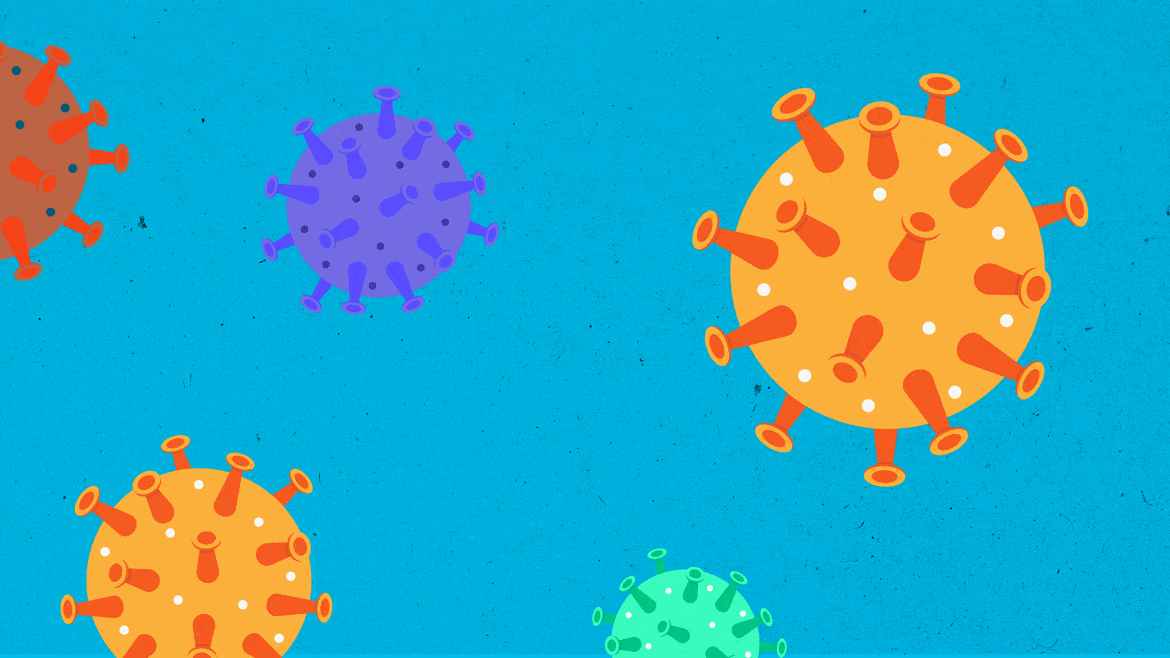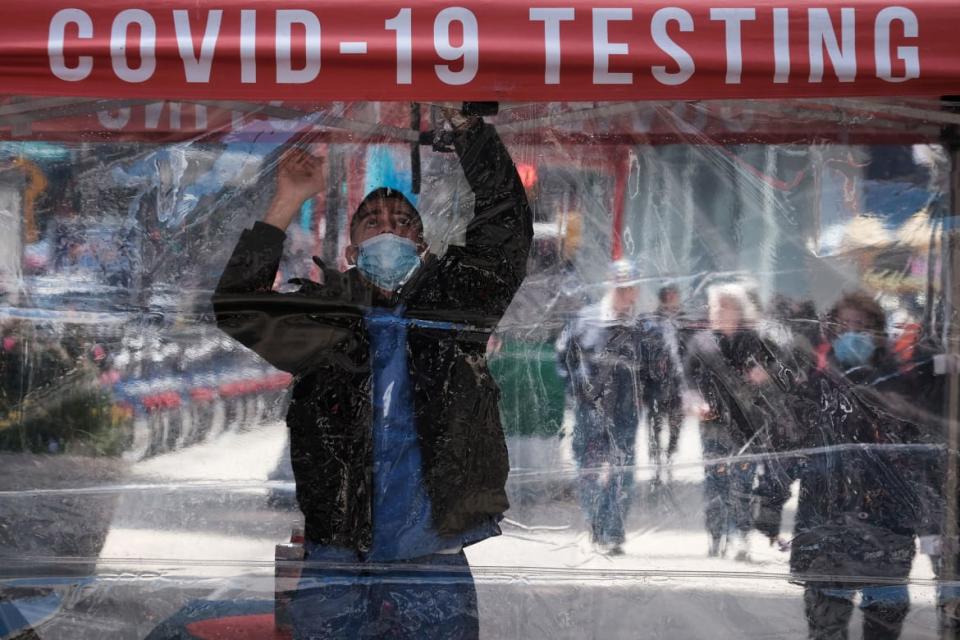Nightmare COVID Variants Are Cracking the Code to Our Immunity

- Oops!Something went wrong.Please try again later.
You might not know it by looking around you at all those unmasked faces, but there’s still an awful lot of novel coronavirus out there. And the virus appears to be mutating faster than ever, producing steadily more contagious variants and subvariants.
The evolutionary trend with SARS-CoV-2 might not mean there are definitely going to be big surges in infections, hospitalizations and deaths. At least not everywhere or for very long.
But it underscores an uncomfortable truth: that despite the lifting of COVID restrictions in most countries that aren’t China, despite many people’s eagerness to move past the pain and uncertainty of the past two years, the pandemic isn’t over. The virus isn’t done mutating.
The latest subvariants are the most transmissible yet. BA.4 and BA.5, both offspring of the Omicron variant, first appeared in South Africa last month. BA.2.12 and the closely related BA.2.12.1 first showed up in New York around the same time.
BA.4 and BA.5 are 10 percent more contagious than their immediate predecessor, the BA.2 form of Omicron. BA.2.12 and BA.2.12.1 are 25 percent more contagious. Equally alarmingly, BA.4, BA.5, BA.2.12 and B.2.12.1 are quickly becoming dominant in their respective regions of origin just a couple months after BA.2 became dominant. BA.2 for its part out-competed and replaced its own parent, BA.1, just a few months after BA.1 became dominant.
China’s New COVID Crisis Could Spawn the Worst Variant Yet
In other words, major new subvariants seem to be coming at us faster and faster. In that sense, the virus might seem like it’s winning a genetic game of chance. Confronted with a semi-permeable barrier of antibodies from vaccines and past infection, the pathogen is becoming more transmissible.
Immune pressure “will increase the rate of selection of those more fit variants that are circulating already in the population,” Edwin Michael, an epidemiologist at the Center for Global Health Infectious Disease Research at the University of South Florida, told The Daily Beast. “This will result in cascades of new variants appearing and spreading in the host population more frequently.”
But this cascade of variants is one price we pay for our expanding, population-wide immunity. You can’t have the latter without getting some of the former. So while it might look like COVID is winning, in fact its genetic victories could be fleeting.
Niema Moshiri, a geneticist at the University of California, San Diego, last year urged The Daily Beast to think of every COVID infection as a gambler playing a slot machine. Each individual infection tends to produce two mutations every two weeks, Moshiri explained. In other words, the virus gets two pulls of the lever twice a month, hoping to score a genetic jackpot that will give it some new advantage over other viruses–and some new way to infect its host.
“What if we had 50 million people pull slot-machine levers simultaneously at the same time?” Moshiri asked. “We would expect at least one person would hit the jackpot pretty quickly. Now, replace the slot machine with ‘clinically meaningful SARS-CoV-2 mutation,’ and that’s the situation we’re in.”
To complete the metaphor, add a mounting sense of urgency on the virus’s part as immunity looms higher all around it. Sensing threats all around it, the novel coronavirus is playing the slots with ever grimmer determination.

A man adjusts a COVID testing tent in Times Square on April 27.
Throughout the viral waves and crashes of the last 30 months, there have never been fewer than several million active COVID cases. During the worst surges in early 2021 and early 2022, there were tens of millions of simultaneous infections. Given the high rate at which the SARS-CoV-2 mutates, it’s no wonder that the virus has produced a steady line of significant new variants—“lineage” is the scientific term.
There was Delta, the more virulent lineage that drove the worst waves of infections of 2021 while much of the world was just beginning to gain access to effective therapies and vaccines. In late 2021, scientists in Botswana and South Africa detected the first cases of a new lineage, Omicron.
Mutations along the spike protein, the part of the virus that helps it grab onto and infect our cells, make Omicron more contagious than Delta. On the worst day of the Omicron wave on Jan. 19, officials tallied no fewer than 4 million new infections in just 24 hours. That’s four times more cases than they counted on the worst days of the back-to-back Delta waves in January and April 2021.
Strong global vaccine-uptake, plus lingering antibodies in tens of millions of people owing to past infection, blunted the worst outcomes from Omicron. When Omicron first showed up, around half the world’s nearly 8 billion people had gotten at least one dose of vaccine. Today more than two-thirds are at least partially jabbed.
Add to that natural antibodies from hundreds of millions of past infections, and the human species’ wall of immunity looks pretty impressive. Breakthrough infections are common, but all those antibodies are really good at preventing the virus from causing serious illness that can end in death.
So cases went way up as Omicron became dominant, but deaths didn’t. On the deadliest day of the Omicron surge on Feb. 9, 13,000 people died globally–5,000 fewer than died on the worst day of Delta on Jan. 20, 2021.
More cases but fewer deaths, a phenomenon epidemiologists call “decoupling,” has come to define COVID’s evolution as we muddle through the third year of the pandemic. There are signs decoupling might actually get more extreme. After all, the immunity that leads to decoupling also spurs a virus to mutate more quickly into ever more transmissible lineages.
Two COVID Variants Just Combined Into a ‘Frankenstein’ Virus
Immunity encourages mutants, which can increase immunity by seeding antibodies from mild infection. It’s an accelerating positive feedback loop whose products are antibodies and viral lineages.
A growing gap between infections and deaths might actually be the best-case scenario, absent the novel coronavirus miraculously “self-extincting” by running itself into a genetic corner. Many experts firmly believe an evolutionary dead end is wishful thinking when it comes to respiratory viruses. “I think self-extinction is vanishingly unlikely,” Jesse Bloom, an investigator at the Fred Hutchinson Cancer Research Center in Washington State, told The Daily Beast.
The bad news is, we probably need to learn to cope with ever more contagious SARS-CoV-2 variants and subvariants showing up faster and faster. The good news is that we know how to cope. BA.4, BA.5, BA.2.12 and BA.2.12.1 do have some ability to get around our vaccine-induced and natural antibodies–“immune escape,” experts call it.

A traveler at Los Angeles International Airport wears a face covering on April 18 after a federal judge in Florida voided the national mask mandate covering airplanes and other public transportation.
Some immune escape doesn’t mean total immune escape. Natural and vaccine antibodies still work. They’re the reason cases and deaths from the basic Omicron lineage decoupled. They’re the reason decoupling is likely with Omicron’s nasty little offspring, too. “The mutants do not seem to be as pathogenic as say, Delta,” Stephanie James, the head of a COVID testing lab at Regis University in Colorado, told The Daily Beast.
All that is to say, expect to hear a lot about new lineages and sublineages in the coming months as they appear and become dominant at an accelerating rate. Don’t be surprised if you catch one of them, even if you’re vaccinated and boosted and maybe even have antibodies from past infection.
But don’t panic. Keep up with your vaccinations and you’ll probably be OK.
Unless, of course, SARS-CoV-2’s evolution takes a dangerous turn. Immune escape has been pretty minor with all the major lineages and sublineages we’ve seen these past two years. That doesn’t mean the virus can’t evolve to achieve significant immune escape. If mutations are like the pathogen playing slots and a jackpot is a new variant, then a variant that can punch through our antibodies is a mega-jackpot.
If the virus ever wins that gamble, everything changes.
Get the Daily Beast's biggest scoops and scandals delivered right to your inbox. Sign up now.
Stay informed and gain unlimited access to the Daily Beast's unmatched reporting. Subscribe now.

